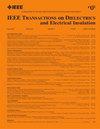Characteristics of Charge Accumulation at the Interface of Double-Layer XLPE Under DC Voltage
IF 2.9
3区 工程技术
Q2 ENGINEERING, ELECTRICAL & ELECTRONIC
IEEE Transactions on Dielectrics and Electrical Insulation
Pub Date : 2024-10-24
DOI:10.1109/TDEI.2024.3486274
引用次数: 0
Abstract
The factory joint is a critical component within high-voltage direct current (HVdc) submarine cable transmission systems, profoundly impacting the stability of equipment operation through its insulation interface performance. However, the characteristics of space charge accumulation at the interface of double-layer cross-linked polyethylene (XLPE) insulation in factory joints, arising from variations in the fabrication process, remain largely unexplored. Therefore, this article investigates the effects of the degree of cross-linking and contact tightness on space charge accumulation characteristics within the double-layer XLPE interface. Experimental findings indicate that the degree of cross-linking alters the carrier mobility of XLPE and the polarity of charges accumulated at the interface of the double-layer sample. In addition, the contact tightness of the double-layer sample can affect the amount of charges accumulated at the interface. Then, based on the simplified bipolar carrier transport model, the key parameters of the simulation are optimized using the particle swarm optimization (PSO) algorithm, and the values of the interface barriers are obtained. Finally, the behavior of interface charge accumulation is successfully explained in terms of the differences in the mobilities and the interface barriers for positive and negative charges. This study offers valuable guidance for the utilization and maintenance of HVdc cable factory joints.直流电压下双层XLPE界面电荷积累特性研究
工厂接头是高压直流(HVdc)海底电缆传输系统中的关键部件,其绝缘接口性能对设备运行的稳定性有着深远的影响。然而,由于制造工艺的变化,双层交联聚乙烯(XLPE)绝缘材料在工厂接头界面处的空间电荷积累特性仍未得到充分研究。因此,本文研究了交联度和接触紧密度对双层XLPE界面内空间电荷积累特性的影响。实验结果表明,交联程度改变了XLPE的载流子迁移率和双层样品界面积聚电荷的极性。此外,双层试样的接触紧密程度也会影响界面处电荷的积累量。然后,基于简化的双极载流子输运模型,采用粒子群优化算法对仿真的关键参数进行优化,得到界面势垒值;最后,从正负电荷的迁移率和界面势垒的差异成功地解释了界面电荷积累的行为。本研究对高压直流电缆厂接头的使用和维护具有重要的指导意义。
本文章由计算机程序翻译,如有差异,请以英文原文为准。
求助全文
约1分钟内获得全文
求助全文
来源期刊
CiteScore
6.00
自引率
22.60%
发文量
309
审稿时长
5.2 months
期刊介绍:
Topics that are concerned with dielectric phenomena and measurements, with development and characterization of gaseous, vacuum, liquid and solid electrical insulating materials and systems; and with utilization of these materials in circuits and systems under condition of use.

 求助内容:
求助内容: 应助结果提醒方式:
应助结果提醒方式:


